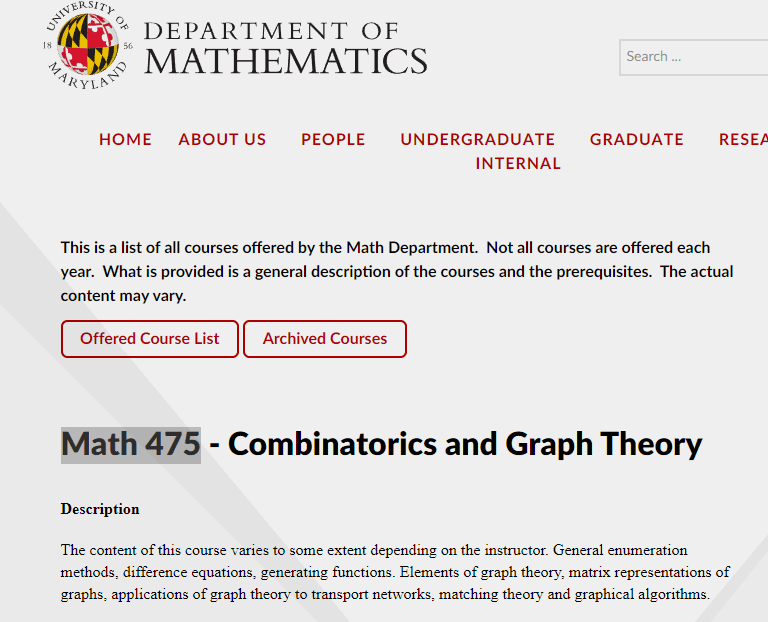数学代写|Math475 Graph Theory
Statistics-lab™可以为您提供umd.edu Math475 Graph Theory图论课程的代写代考和辅导服务!

Math475 Graph Theory课程简介
The content of this course includes general enumeration methods, which involves counting techniques used to solve combinatorial problems. The course also covers difference equations, which are used to model and solve recurrence relations. Another topic covered is generating functions, which are used to convert combinatorial problems into algebraic problems that can be solved using calculus and algebra.
In addition, the course includes elements of graph theory, which is the study of graphs and their properties. This includes matrix representations of graphs, which are used to analyze the structure of graphs. The course also covers applications of graph theory to transport networks, where graphs are used to model and analyze transportation systems.
Matching theory and graphical algorithms are also covered in this course. Matching theory is the study of matching problems, where we try to match elements from one set to another according to certain criteria. Graphical algorithms are algorithms that operate on graphs, and are used to solve problems such as shortest path and maximum flow problems.
PREREQUISITES
Sample Textbooks
First Course in Graph Theory, by Gary Chartrand
Introduction to Enumerative Combinatorics, by Miklos Bona
Applications
Computer science, physics, economics, biology, chemistry
If you like this course, you might also consider the following courses
MATH 401, MATH 405, MATH416, Study abroad program Budapest Semesters of Mathematics
Additional Notes
Students interested in grad school in STAT or computer science should consider this course. A large element of the course involves puzzles that are very easy to understand, but requiring thinking outside the box.
Math475 Graph Theory HELP(EXAM HELP, ONLINE TUTOR)
3.1.7 Either draw the desired graph or explain why no such graph exists: A 9 vertex, 2-component, simple graph with exactly 10 edges and 2 cycles.
Let’s first consider the number of edges that a 2-component graph with 9 vertices can have. In order for a graph to have 2 components, it must be disconnected. The maximum number of edges in a disconnected graph with 9 vertices is achieved when one component has 8 vertices and the other has 1 vertex. In this case, the 8-vertex component can have at most 28 edges (a complete graph), and the 1-vertex component can have at most 0 edges. Therefore, the total number of edges in a 2-component graph with 9 vertices is at most 28.
Now, let’s consider the number of cycles that a 2-component graph with 10 edges can have. Each cycle in a simple graph must have at least 3 vertices, so the maximum number of cycles that a graph with 10 edges can have is achieved when each cycle has 3 edges. In this case, the total number of cycles is 10/3, which is not an integer, so there cannot be exactly 2 cycles in such a graph.
Therefore, there is no graph that satisfies all the given conditions.
3.2.2 Draw all rooted tree types with 5 vertices. How many different graph isomorphism types do they represent?
There are only two types of rooted trees with 5 vertices: the path tree and the star tree.
- Path tree: This tree consists of a linear chain of 5 vertices, where each vertex has degree 1 except for the two endpoints, which have degree 1 and 2, respectively.
markdownCopy code * --- * --- * --- * --- *
1 2 3 4 5
- Star tree: This tree consists of a central vertex with degree 4, and 4 leaves, each connected to the central vertex.
markdownCopy code *
|
* --- * --- *
|
*
There are only two different graph isomorphism types for these trees, since any permutation of the vertices of the path tree or the star tree will result in an isomorphic tree of the same type. Therefore, there are 2 different graph isomorphism types for rooted trees with 5 vertices.
Textbooks
• An Introduction to Stochastic Modeling, Fourth Edition by Pinsky and Karlin (freely
available through the university library here)
• Essentials of Stochastic Processes, Third Edition by Durrett (freely available through
the university library here)
To reiterate, the textbooks are freely available through the university library. Note that
you must be connected to the university Wi-Fi or VPN to access the ebooks from the library
links. Furthermore, the library links take some time to populate, so do not be alarmed if
the webpage looks bare for a few seconds.

Statistics-lab™可以为您提供umd.edu Math475 Graph Theory图论课程的代写代考和辅导服务! 请认准Statistics-lab™. Statistics-lab™为您的留学生涯保驾护航。